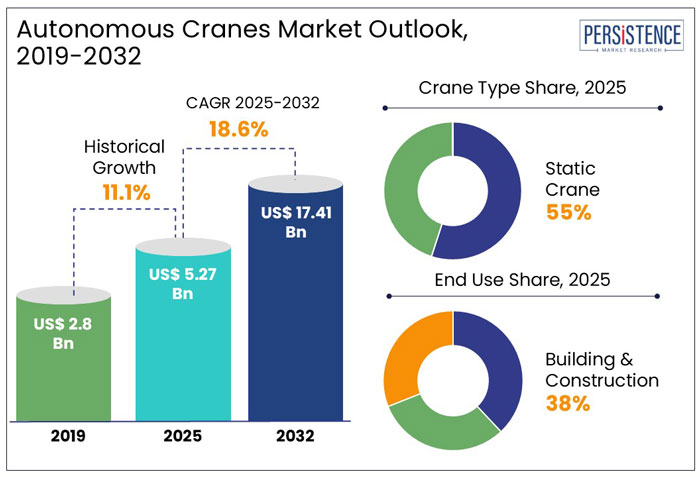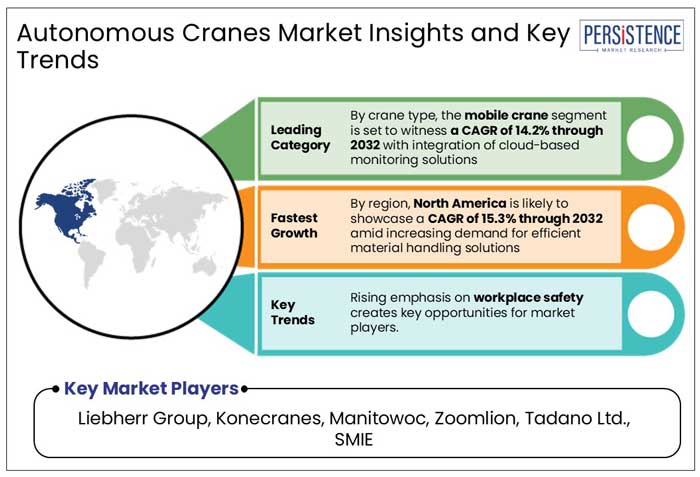Industry: Automotive & Transportation
Published Date: February-2025
Format: PPT*, PDF, EXCEL
Delivery Timelines: Contact Sales
Number of Pages: 180
Report ID: PMRREP35128
The global autonomous cranes market size is anticipated to rise from US$ 5.27 Bn in 2025 to US$ 17.41 Bn by 2032. It is projected to witness a CAGR of 18.6% from 2025 to 2032.
As per Persistence Market Research (PMR), the market is experiencing significant growth, driven by technological innovations and increasing demand across various industries. Incorporation of Artificial Intelligence (AI) and Machine Learning (ML) in crane operations enhances efficiency and safety, contributing to market growth.

Key Highlights of the Autonomous Cranes Market
|
Global Market Attributes |
Key Insights |
|
Autonomous Cranes Market Size (2025E) |
US$ 5.27 Bn |
|
Market Value Forecast (2032F) |
US$ 17.41 Bn |
|
Projected Growth (CAGR 2025 to 2032) |
18.6% |
|
Historical Market Growth (CAGR 2019 to 2024) |
11.1% |
Rising Demand for Efficiency and Safety in Material Handling Boosted Autonomous Crane Integration
The market for autonomous cranes witnessed significant growth from 2019 to 2024 and is poised for remarkable expansion in the future. In 2019, the market was valued at nearly US$ 2.8 Bn, and the surge was driven by increasing adoption of automation across various industries, aiming to enhance efficiency and safety in material handling operations.
The construction sector, in particular, significantly contributed to this growth, integrating autonomous cranes to streamline processes and reduce human intervention. For instance,
Government Support for Smart Factories to Augment Adoption of Autonomous Cranes
Over the forecast period, the market's upward trajectory will likely continue beyond 2025. Technological developments, rising safety concerns, and high demand for efficient material handling solutions are anticipated to fuel this growth. By 2032, the market is projected to reach US$ 17.41 Bn, underscoring the transformative impact of automation in the crane industry. For example,
Growth Drivers
Adoption of Machine Learning in Cranes to Enhance Load Optimization and Precision
Integration of innovative technologies such as Artificial Intelligence (AI), Machine Learning (ML), and the Internet of Things (IoT) has significantly enhanced the capabilities of autonomous cranes. For example,
Such innovations help improve operational efficiency, precision, and safety in material handling. AI-enabled autonomous cranes can optimize load lifting and placement, reducing human error and increasing productivity.
Capital-intensive Deployments to Slow Down Widespread Adoption of Automated Cranes
Implementing autonomous crane systems requires substantial capital investment in innovative hardware and software. This high upfront cost can be a significant barrier, especially for small and medium-sized enterprises (SMEs). For instance,
The maintenance and potential need for specialized personnel to manage these novel systems add to the financial burden. Unstable prices of raw materials and limited availability of skilled workers further restrain market growth.
Rising Workplace Safety Standards to Push Demand for Autonomous Cranes in Hazardous Sectors
Increasing focus on enhancing workplace safety across various industries is a major boost for the market. Autonomous cranes can minimize human involvement in hazardous operations, reducing the risk of accidents and injuries.
The safety advantage is driving demand, particularly in sectors such as construction, mining, and marine operations. Global ports are increasingly investing in automation to enhance safety and efficiency.
As technological developments propel the market forward, high initial costs pose challenges. However, the increasing emphasis on workplace safety presents a significant opportunity for market expansion.
Crane Type Insights
Fixed Installation Advantages Make Static Cranes Essential for High-capacity Operations
Static cranes are permanently installed at a specific location and are integral to operations in sectors such as marine and offshore, mining and excavation, and construction. These are set to hold a share of 55% in 2025.
Its design allows for greater lifting capacity at higher elevations, making static cranes indispensable for heavy-duty tasks. The increased adoption of static cranes in these industries can be attributed to their ability to handle substantial loads with enhanced stability and precision.
The preference for static cranes in several applications underscores their importance in operations that demand high lifting capacities and stability. Their fixed nature provides a reliable solution for repetitive tasks in a confined area, contributing to their dominant position in the market.
Mobile cranes, on the other hand, are projected to witness a CAGR of 14.2% through 2032.
End Use Insights
AI and Machine Learning to Transform Autonomous Cranes, Enhancing Efficiency in Construction
Globally, there has been a significant surge in urbanization, leading to increased construction activities. This growth necessitates efficient and safe material handling solutions, which autonomous cranes provide. The building and construction sector is projected to hold a share of 38% in 2025.
Autonomous cranes minimize human intervention in hazardous tasks, thereby reducing the risk of workplace accidents. For example,
Integrating unique technologies such as artificial intelligence (AI) and machine learning (ML) in autonomous cranes enhances their operational capabilities, making them more appealing for large-scale construction projects. As construction projects become more complex and timelines more stringent, the reliance on autonomous cranes is set to increase, solidifying this sector's leading position in the market.

Automation Investments in North American Ports Spark Labor Disputes Amid Market Growth
The North American autonomous cranes market is experiencing significant growth, driven by innovations in automation and increasing demand for efficient material handling solutions across various industries. The region is projected to generate a share of 35% in 2025 and witness a CAGR of 15.3% through 2032.
The integration of Artificial Intelligence (AI), Machine Learning (ML), and Internet of Things (IoT) technologies into crane operations has enhanced automation capabilities, leading to increased adoption in sectors such as construction, logistics, and manufacturing. Autonomous cranes reduce the reliance on manual labor, minimizing human error and enhancing workplace safety. It is particularly beneficial in industries involving hazardous tasks, leading to improved operational efficiency and reduced accident rates.
North American ports are increasingly investing in automation to enhance operational efficiency. However, this shift has sparked debates between port authorities and labor unions. For example,
Infrastructure Boom and Megaprojects to Propel Asia Pacific through 2032
Asia Pacific is experiencing rapid growth in the autonomous cranes market, driven by significant infrastructure development, technological innovations, and increased investments in automation across various industries. Rapid urbanization and government-backed megaprojects in countries like China, India, and Southeast Asian nations are fuelling the demand for advanced construction machinery, including autonomous cranes.
The integration of artificial intelligence (AI), machine learning (ML), and Internet of Things (IoT) technologies into crane operations enhances efficiency and safety, making them more appealing to industries such as construction, mining, and logistics.
Europe’s Focus on Precision and Efficiency to Fuel Demand for Autonomous Cranes
The European autonomous cranes market is experiencing notable growth, driven by innovations in automation, a strong emphasis on workplace safety, and the presence of leading crane manufacturers. Local manufacturers are at the forefront of integrating advanced technologies such as artificial intelligence (AI), machine learning (ML), and the Internet of Things (IoT) into crane operations. Such innovations enhance efficiency, precision, and safety in material handling.
The region’s market is poised for continued growth and is supported by technological advances and a strong emphasis on safety and environmental considerations. As industries increasingly adopt automation to enhance efficiency and comply with stringent regulations, demand for autonomous cranes is expected to rise. For example,
The autonomous cranes market is highly competitive, with key players focusing on technological developments, strategic partnerships, and geographic expansion. Leading companies dominate the industry through continuous research and development investments as well as automation-driven solutions.
Key companies also leverage AI, IoT, and cloud-based monitoring to enhance crane efficiency and safety. Moreover, increasing demand for automated lifting solutions in construction, ports, and mining is prompting mergers, acquisitions, and joint ventures. The presence of regional and global players intensifies competition, making innovation and customization key differentiators for market success.
Key Industry Developments
|
Report Attributes |
Details |
|
Historical Data/Actuals |
2019 - 2024 |
|
Forecast Period |
2025 - 2032 |
|
Market Analysis Units |
Value: US$ Bn/Mn, Volume: As applicable |
|
Geographical Coverage |
|
|
Segmental Coverage |
|
|
Competitive Analysis |
|
|
Report Highlights |
|
|
Customization and Pricing |
Available upon request |
By Crane Type
By End Use
By Region
To know more about delivery timeline for this report Contact Sales

The market is set to reach US$ 5.27 Bn in 2025.
Liebherr Group, Konecranes, and Manitowoc are a few key players.
The industry is estimated to rise at a CAGR of 18.6% through 2032.
North America is projected to hold the largest share of the industry in 2025.
The market for autonomous cranes is anticipated to reach a value of US$ 17.41 Bn by 2032.